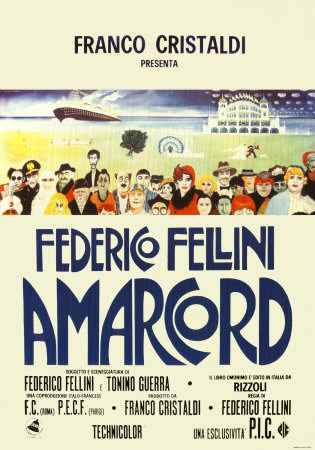
AMARCORD
Italy, 1973, 123 minutes, Colour.
Directed by Federico Fellini.
After exploring society and its modern victims during the 60's, after visualising the oddities of Rome old and new in the early 70's, Federico Fellini seems to have purged himself of so many of his psychological, national, cultural and religious obsessions (making excellent films in the process). A mellower Fellini now reminisces about Italians in the 30's, his period of youth, and offers an Italian Under Milkwood; the same mixture of admiration, irritation, nostalgia and longing for self understanding and appreciation of life, foibles and all. The result, beautifully and entertainingly done, is a human film that is an artistic documentary as well as a visually poetic exploration of Fellini's spirit.
1. The film title means 'I Remember'. How important was this for the meaning of the film? (Liken it to Under Milkwood).
2. How much nostalgia was there in the remembering? Remembering a past Italy? Past people? The past of Fellini? Was it a real past that was being remembered or a romanticised past? Why?
3. How did the film indicate that the past explains the present? Was this evident in the film?
4. What insight into Italy did the film give? To its atmosphere and seasons to its people, their traditions, their styles, way of life, the temperament of the Italians? The role of Italy in the 30s and its people in the 30s? which sequences best illustrated this?
5. The film dealt with the Fascist period. How well was this illustrated? The presence of Mussolini? The visit of the Fascists? Mussolini's face in flowers? The attack on the socialists? What are the implications of this presentation of Fascism? what judgements is Fellini making on Fascism and its influence on Italians? Is he fair?
6. How interesting was the picture of the town? Did the film give a broad, realistic, as well as fantasy, picture of a town in the 30s? Of the people there, what they believed in, what they did? How valuable an experience is this? For non-Italians?
7. Comment on the structure of the film with the seasons of the year: the puffs at the beginning and their symbolism, being blown about by the winds? The picture of summer: the heat, the picnics, the happiness, and then the moving into autumn with school and ordinary life? The snows of winter? The coming of spring and the return of the puffs; beginning where it ended? A picture of life? As a microcosm of the whole of Italy? A year for a lifetime? And the role of the narrator, and his being mocked, by snowballs and rude comments etc.? What function did the narrator have for audience identification?
8. How interesting were the people in the town? Did we get to know them? The presence of Gradisca? In her red coat, the stories told about her, the young boys meeting her in the theatre etc.? The role of the prostitute ever-present, for instance, on the working site, the way the boys talked about her? The role of the priest and confessions? The people that passed by?
9. An illustration of life in the town was the bonfire. What did it mean for the people at this season? The old pagan traditions in a Christian society? Assimilated? Superstitions and belief?
10. The sequence of Mussolini and the Fascists? And the fantasies of the boy getting Harried? A "fact-boy" and a "fantasy-girl"? A symbol of the dreams of the people?
11. How interesting were the sequences of the family: at home, the meal, and their anger, the interactions? How humorous, how real? The grandfather and his memories, the clash with mother and father, the simple uncle, the children? The maid? The sequence of the picnic as an illustration of their family life? The father's socialism and his being called before the police? The mother's wisdom in giving advice about the father? The public clashes of the sympathy of the mother?
12. The importance of the mad relation? what was this meant to illustrate? Was he a symbol of mad Italians? The humour, his being up the tree, his calling out for a woman? The way the family handled this situation? An illustration of ordinary life?
13. The picture of the boys: at school, their education and its effect on them, their talking together, the going to the films, their urinating, the fact that they got on well together and the way they talked? The central boy and his place in this? At school, mocking, his encounter with the woman with the great breasts? The meaning of these symbols?
14. Fellini often has a preoccupation about sexuality. Was it manifest here? Gradisca, the prostitute, the woman with the great breasts, the family life and discussions about sexuality? The young boy asking his mother about her courting etc.? How easy an attitude did Fellin! have here? Puritanical? Balanced?
15. Fellini often presents religion in a mocking way and investigating its impact on society. The comment on religion here? The confession sequences? Their humour? The effect of religion on the people?
16. What are Fellini's ideas on patriotism?
17. What does he see as good in the town? As bad? As good and bad in people? How much is this a film of an older, mellowing man? Why?